Exploring East Gippsland, Victoria

For today’s traveller, the Gippsland city is an ideal base to explore not only the coast but remote and fascinating mountain communities.
Bairnsdale to Dargo – 113km
After driving from Bairnsdale through mountain forests of fragrant eucalypts for more than 30 winding kilometres, you see glimpses of vast emerald-green slopes and, before long, a wide valley that might be the legendary Shangri La.
Nestled in the foothills of the Dargo High Plains, the Dargo Valley is one of Victoria’s most remote communities. At its epicentre is the town of Dargo, population 150.
The Dargo Valley was first settled by Europeans in 1839, when pastoralist Lachlan Macalister established an 8000-hectare run. The town of Dargo itself didn’t develop until the 1860s after traces of gold were discovered at Crooked River.
The rush was on, and gold-hungry miners tackled rugged mountainous terrain in their quest for wealth at Mount Pleasant, later called Grant, which was one of the main towns that came into being as part of the Crooked River gold rush. Other gold-mining settlements established in the remote hills were called Talbotville, Howittville, Winchester, Thiel Town, Spring Hill, Summer Hill and Stonewall. Indigenous Australians guided many European explorers and gold miners through the mountains.
By the end of 1865 Grant, 20km north-west of Dargo, had 15 hotels, a church, courthouse, police station, medical hall, numerous stores and a newspaper – the Crooked River Chronicle. The population grew to around 2000. By 1881 the gold was gone, and with it the miners, and like many goldrush townships the settlements soon withered into ghost towns.
What’s left of Grant and Talbotville – and there’s very little – are located within the Grant Historic Area, which reveals some features of mining days including a lonely cemetery, township sites and mining relics. The Grant Historic Area is part of an Aboriginal cultural landscape in the traditional Country of the Gunaikurnai Peoples.
For those who enjoy a stroll in the bush there are more than 100 native plant species and wildlife includes swamp wallabies, bare-nosed wombats, eastern grey kangaroos, cockatoos, parrots, superb lyrebird, and a variety of owl species.
Dargo, first surveyed in 1864, developed as a supply centre for the mountain diggings. After the gold rush Dargo clung to life in its isolated valley: walnut trees were planted – you still see groves of century-old trees – cottages built, lots of weeping willows planted, and sheep and cattle raised. In 1959 a sawmill opened south of town.
Although Dargo’s population is just 150, the town is home to not one but two pubs, the Dargo Hotel and Dargo River Inn. The Dargo River Inn, built on the site of the old sawmill, is a welcoming tavern run by Kelly Underwood and Greg Travers. Set on several hectares, the tavern complex includes self-contained cabins and campsites across grassy grounds with sweeping views of surrounding mountains. A large beer garden is a popular spot for a cold ale, and the pub serves pub favourites such as steak sandwiches, parmas and fish and chips.
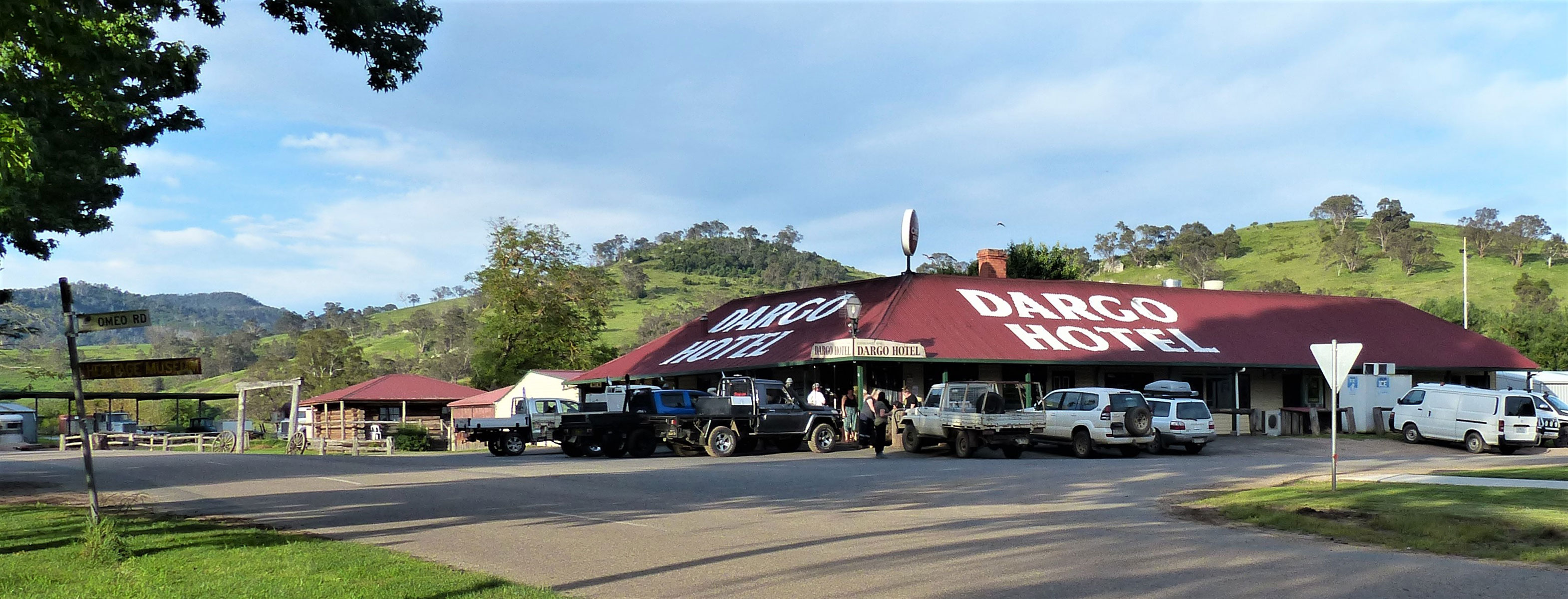
The historic Dargo Hotel, in the middle of the old town, is a rustic watering hole with walls and ceilings festooned with stubby holders, old saddles, photos and maps. The Dargo Hotel you see today was built on the site of the circa 1881 Bridge Hotel, which burned down in 1898. Parts of the ‘new’ hotel were constructed from buildings demolished in Grant.
Since 1882, just four families have been involved in the running of the pub, three of whom can trace their forbears back to the town’s early days. They include Helen Hall, a fourth generation local and the pub’s current owner.
“Visitors love the character and beauty of this region,” said Helen. “Not just the glorious mountains, but bush tracks for hiking and four-wheel driving, gold panning, and fishing in pristine rivers.”
The pub’s menu features the likes of crumbed camembert, battered prawns, Gippsland steaks, and those crowd-pleasers, parmas with an assortment of toppings. We’re warned by locals that the parmas ($30) are so big it might be best to tackle a half-serve ($20), and they’re right.
Today, many high-country cattlemen have homes in this stockbreeding and agricultural district including Bill ‘Bullbar’ Maiden, who owns a cattle station on the Wonnangatta River.
“People travel from all over Australia to visit the Dargo Hotel, just as they do other legendary Aussie pubs such as the Humpty Do and Birdsville hotels,” said Bullbar.
“Dargo is an old, sparsely populated town and is very laid-back, which is why it’s child, caravan and dog-friendly.”
It’s a local’s birthday during our visit and the pub is packed. Toasts are made in the bar as kelpies wait patiently out the front for their owners. We see a bloke on a ride-on lawnmower heading towards the pub; it can only happen in a place like Dargo.
Bairnsdale to Buchan – 76km
Buchan is a pleasant little town sitting snugly amid an amphitheatre of green hills featuring a couple of cafes, the Caves Hotel and the historic Buchan Caves Reserve. From Bairnsdale, the Great Alpine Road to Buchan snakes through great swathes of eucalypts as it threads through Bruthen.
In Bruthen you turn onto the Buchan-Nowa Nowa Road, which climbs 48km upwards through a series of twists and turns to Buchan, population 440. Nestled in the foothills of the Snowy River Valley, Buchan is the meeting point of the Snowy and Buchan Rivers.
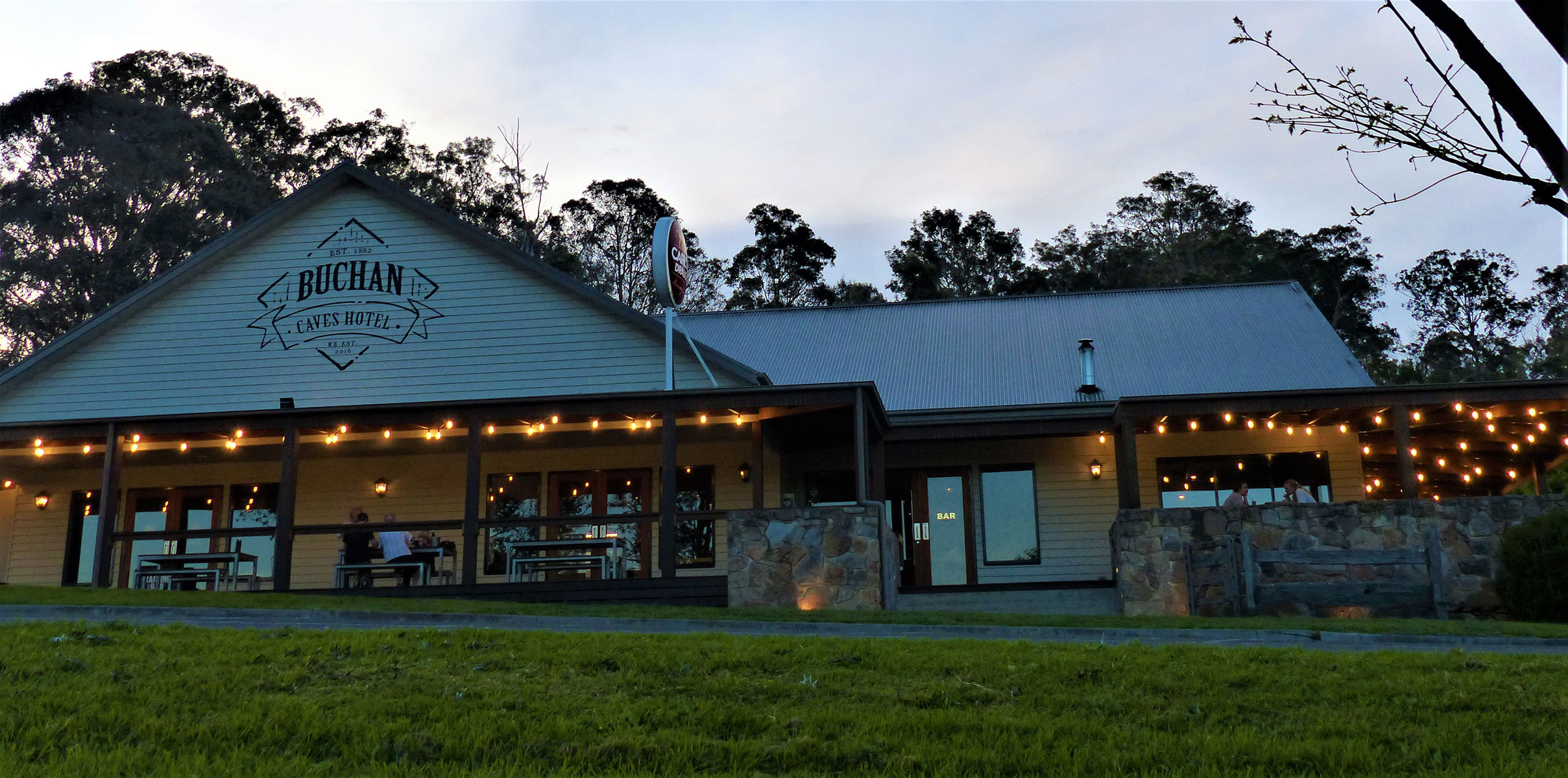
Buchan’s original Caves Hotel, built in 1881, was razed to the ground in a 2014 fire, and the Victorian high-country community was left without its time-honoured watering hole. Then came one of Australia’s biggest crowdfunding campaigns, which raised $600,000 to build the new Buchan Caves Hotel on the same site. After months of hard work, and lots of voluntary labour, the new hotel, built in a style inspired by its past heritage, opened in December 2016.
Darren Williams, who grew up near Bairnsdale, and his wife Cathy moved to Buchan three years ago. The couple own Stockman’s Camp, eight kilometres from town, and the Caves Hotel. Today this cheery pub is popular with locals and visitors alike, and serves traditional fare such as local steak and, naturally, parmas.
Sitting on the wide deck of the hotel in the town’s main street, there’s not a sound – no cars flying past, just the lowing of cattle in surrounding paddocks, warbling magpies and laughing kookaburras, and a dog barking in the distance. The old town, proclaimed in 1873, is not always this quiet.

St Dymphna's church est. 1896, Buchan
The Buchan Rodeo, held annually on Easter Sunday, has been raising funds for local community services for more than 50-years and the Buchan Caves Reserve, well-known for its network of underground caves, attracts more than 100,000 visitors each year.
The limestone rock at Buchan was laid down about 300-400 million years ago when the ocean, alive with shellfish and coral, covered this part of East Gippsland. The region’s 350 caves derive from the skeletons of shellfish and coral, and fossilised sea creatures are still visible embedded in the walls.
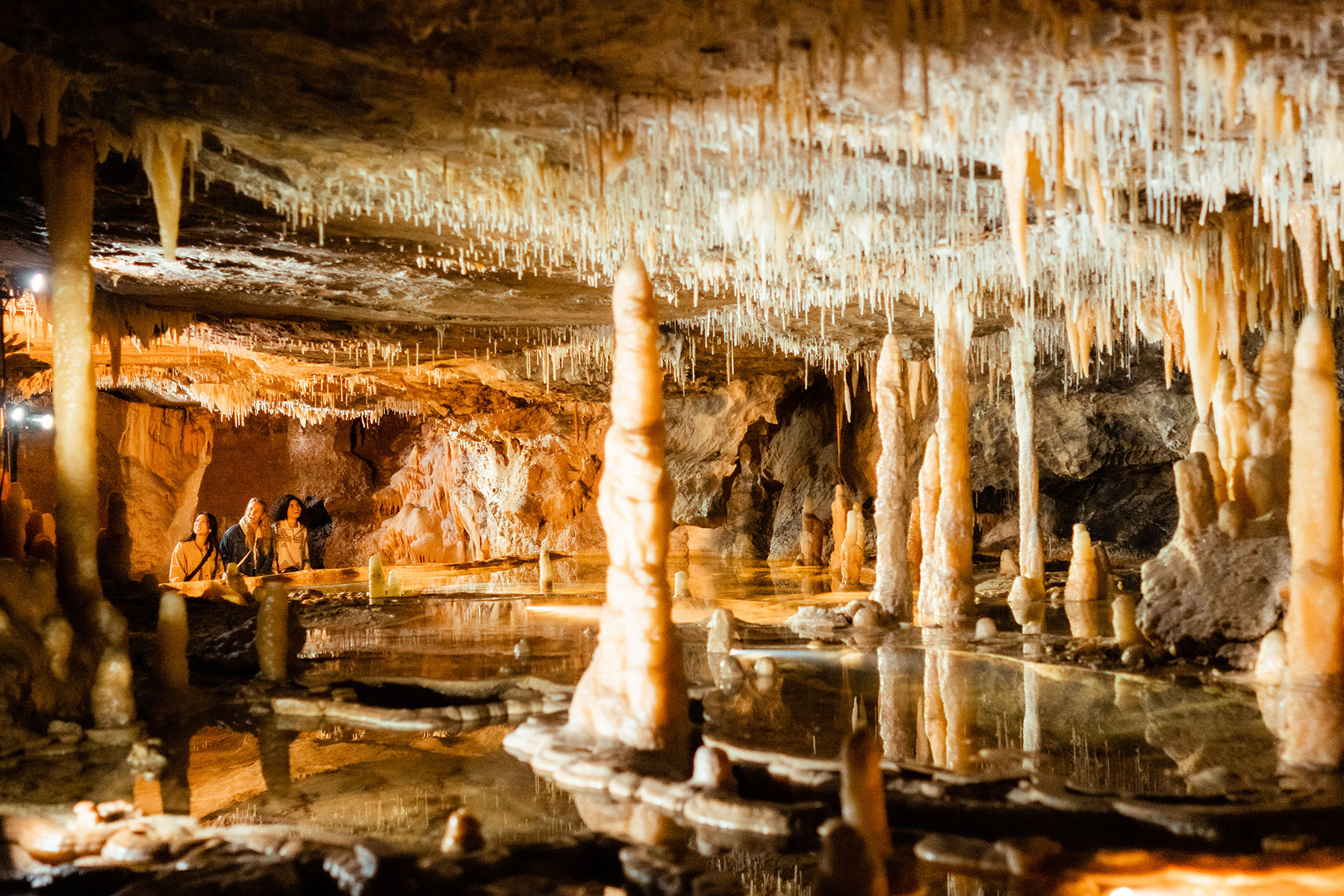
Buchan Caves (Image Tourism Victoria)
The general public can only venture into two caves (unless you are part of a caving association such as the Victorian Speleological Association), and this must be on a guided tour.
Choose from the Fairy Cave or Royal Cave, or venture into both underground wonderlands. The Royal Cave is known for its glassy calcite-rimmed pools, while Fairy Cave features intricate stalactites and stalagmites, vast open caverns and an ancient flowing stream.
Buchan Munji, the Buchan caves region, was traditionally an important meeting place for Gunaikurnai people, dating back more than 18,000 years. Today Buchan Caves Reserve is jointly managed by the Gunaikurnai Nation and Parks Victoria. The 285-hectare, heritage-listed reserve is home to a visitor centre, kiosk, playground, barbecue facilities and campsites amid manicured grounds landscaped in 1929.
Both native and exotic deciduous trees are spectacular here in autumn, when the reserve is a kaleidoscope of reds, oranges and yellows. Local wildlife includes superb lyrebird, boobook owl, echidna, brush-tailed possum, swamp wallaby, lace monitor, and eastern grey kangaroo, which are generally seen close to the campgrounds.
Darren and Cathy William’s Stockman’s Camp is on the site of an old stock route, when stockmen drove cattle from the mountains to Port Albert after the region was first settled in the 1830s. Darren is an accomplished horseman, bushman and stockman, and finalist at Corryong’s annual Man from Snowy River Bush Festival (being held 13-16 April 2023).
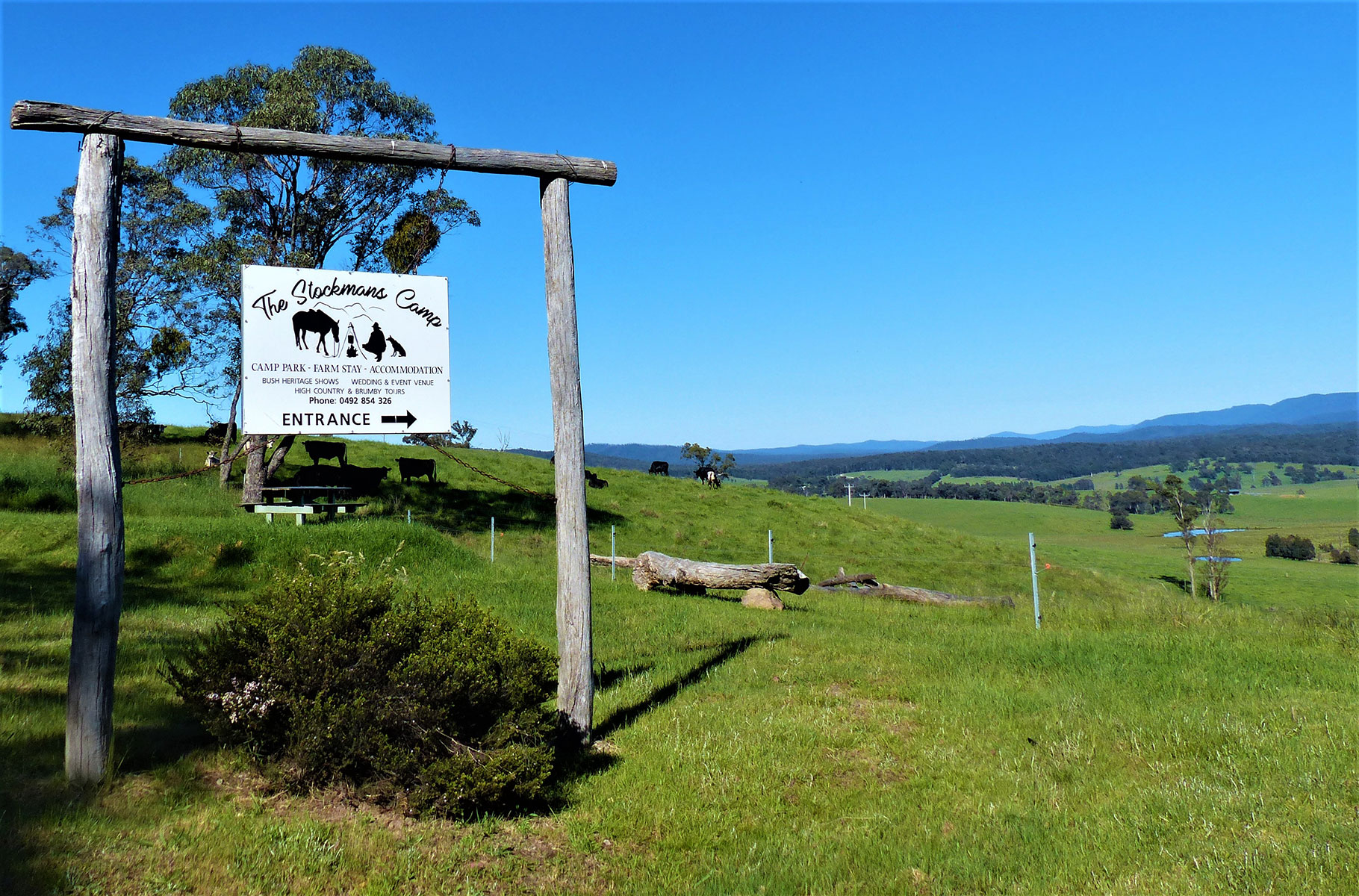
A working farm, Stockman’s Camp features a collection of historic buildings, grassy caravan sites amid shaded gardens where peacocks wander around, and glorious rural views. Nearby Buchan South is the site of a deposit of black marble that was used in the construction of pillars for Melbourne’s Shrine of Remembrance and Australia House in London. There’s also a moving War Memorial at the site of the old Buchan South School.
Incredibly, from here it’s only a 40-minute drive to the hustle and bustle of Lakes Entrance.
Bairnsdale to Omeo – 123km
“Omeo being so far from any other centre of population, and the country, by its rough nature, offering great inducements to horse and cattle stealers for their nefarious traffic, a good strong lockup is constructed in the town,” wrote a reporter from the Weekly Times in 1881.
“The lockup is built of large, thick logs and divided into three cells, from which there would be some considerable difficulty in escaping, although once clear of the town the runaway would have little difficulty in hiding himself.”
Situated on Livingstone Creek, Omeo is a fascinating frontier town that was once the centre of one of Australia’s toughest goldfields. Founded from 1851, Omeo was a rowdy place – the goldfields were originally policed by miners themselves, and those declared prisoners chained to a tree.
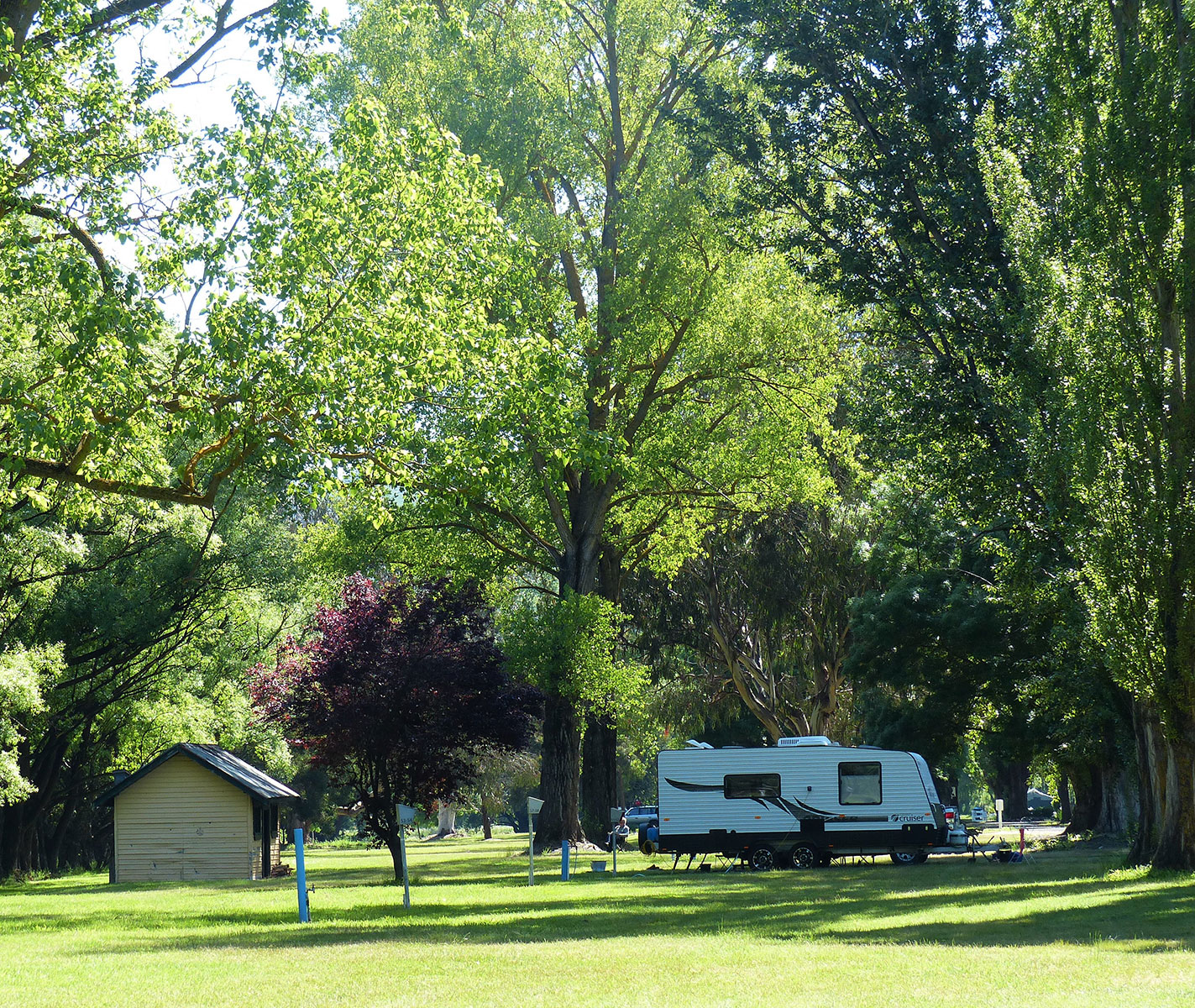
Omeo Caravan Park
You can still see Omeo’s log jail, built in 1858, at the A. M. Pearson Historical Park, along with two courthouses, a police cookhouse, police residence and stables.
Omeo is 123km north of Bairnsdale along the scenic Great Alpine Road. First stop is Bruthen, 27km north-east of Bairnsdale, which has a number of historic buildings, shady gardens, the Bruthen Inn Hotel, and the Bullant Brewery, producing craft ales such as Pig and Whistle Brown Ale and Bark Sheds Wheat Beer.
From here it’s just over 69km to Swifts Creek along windy roads through hilly countryside, hugging the lovely Tambo River for part of this scenic journey through forests and pasturelands.
Ensay, about 20km south of Swifts Creek, is a small town beside the Tambo River. Ensay’s Little River Inn was first granted a liquor license in 1847 and has held it to this day. The Ensay Winery and Vineyard is a family-owned vineyard offering tastings and sales of Shiraz, Cabernet Sauvignon, Chardonnay and Pinot Noir wines that are grown, made and sold on the property, and is well worth a pitstop.
Swifts Creek, situated at the junction of the Tambo River and Swifts Creek, was established in the 1850s. The town later became known for its timber industry, and today features a country pub and a bakery with a circa 1866 wood-fired oven.
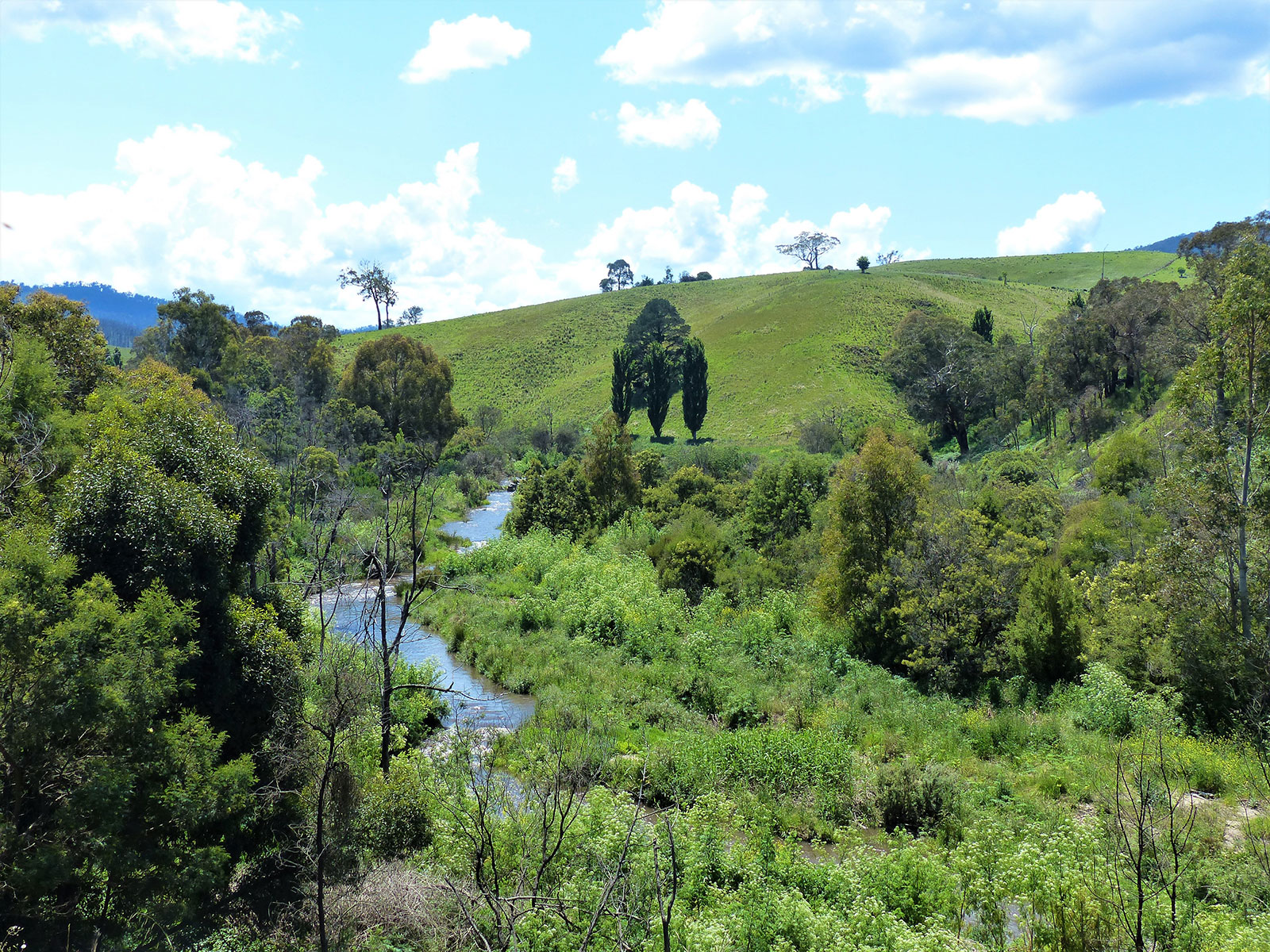
Tambo River
At Swifts Creek is the turnoff to the ghost town of Cassilis, and it’s well worth the detour to visit this picturesque valley, once known as Long Gully, which lies on Gray’s Creek, a tributary of Swifts Creek. Some gold was found here in the 1850s, but the rush was short-lived, and the area soon returned to its sylvan splendour.
The idyll ended in 1885 with the discovery of gold-bearing quartz reefs at Long Gully, and the rush was on again: just four years later a settlement at the northern end of the gully called Cassilis had houses and businesses springing up everywhere.
There was a gold battery in operation, many cottages, a general store, Mechanic’s Institute, school, two hotels, an Oddfellow’s Lodge, butcher, baker, and Dunin’s Coffee Palace, which later became the Cassilis Wine Palace.
Tongio West, four kilometres east of the Cassilis metropolis, also became a busy place. There was a profusion of sporting clubs including cricket and football teams, as well as a band, a rifle range, and the Cassilis Ladies Rifle Club.
Heavy machinery to work the reefs was hauled over the mountains by bullock teams, and Victoria’s first hydroelectric power station was established at Victoria Falls near Cobungra, 23km west of Omeo, to provide light and power for mines including the huge King Cassilis and Mount Hepburn mines. Today the 3600-hectare Cassilis Historical Area includes the heritage-listed mines and relics such as old tramways to mullock heaps.
Once-prosperous, Cassilis is now a peaceful place with a scattering of farms, and Cassilis Estate, built on the site of the Cassilis Wine Palace. The estate produces wines including Pinot Noir and Chardonnay, as well as Cassilis Heritage Cider, made from a blend of apple varieties grown in surrounding orchards.
It’s rough and tumble days long over, Omeo is now a sleepy township of around 400 people, based on cattle, sheep and timber, and is a pleasant place to pause and explore. The town has two pubs, known locally as the top pub and the bottom pub, and officially, the Hilltop and Golden Age hotels. There are several interesting walks around town including the Oriental Claims Historic Area and Ah Fong’s Loop Walk.
At Dry Gully Creek about two kilometres from Omeo is a suspension bridge built to honour the miners who established the Livingstone Creek diggings. The bridge takes you to the heritage-listed Oriental Claims area, once one of the world’s largest gold-sluicing operations. Some 1600kgs of gold is said to have extracted from the area and many mining remnants remain.
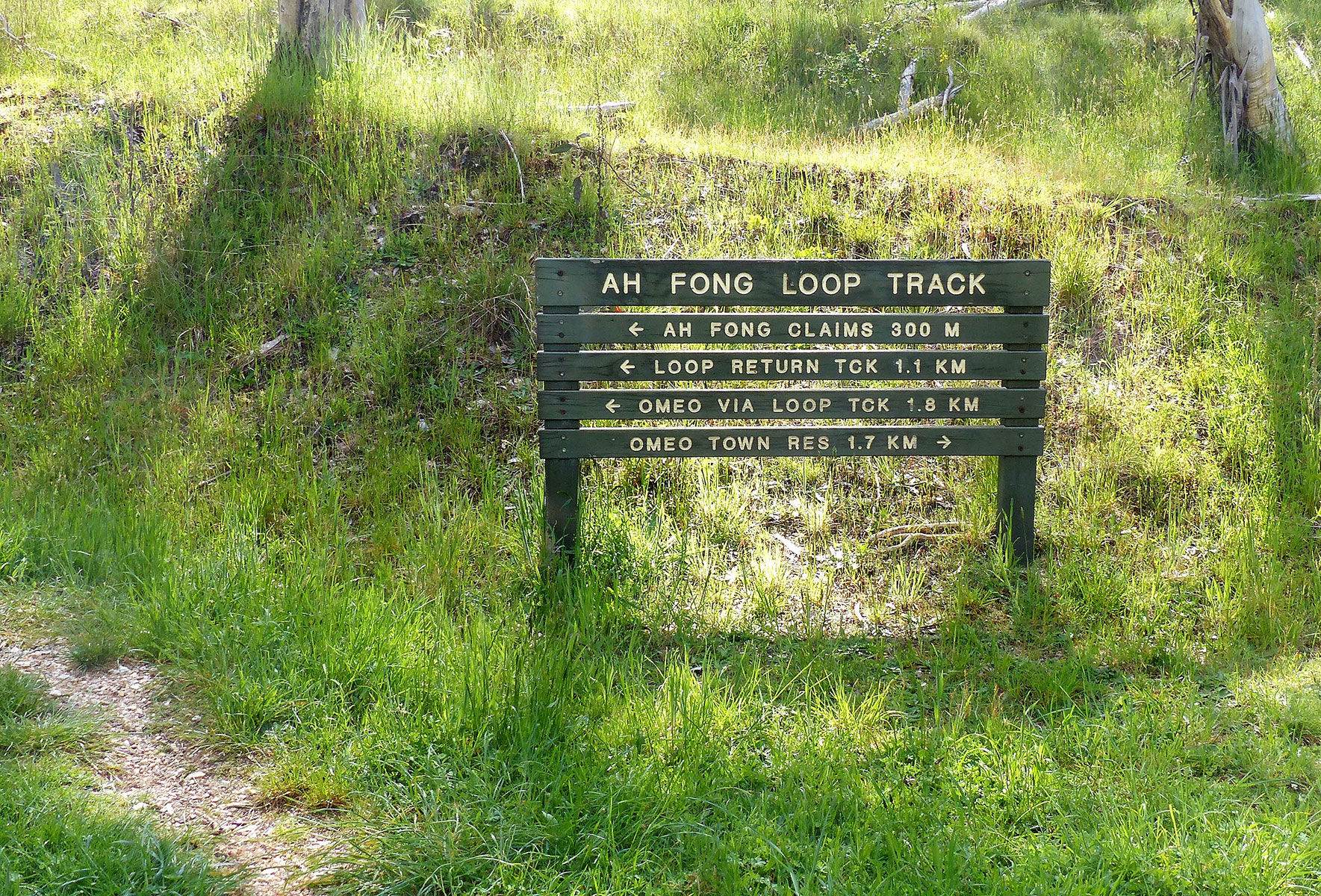
Ah Fong’s Loop Walk, also at the site, is a 1.5 km trail along Livingston Creek sites worked by Chinese goldminers including Ah Fong in the 1870s. It’s said Ah Fong struck it rich, his claim yielding some 170kgs of gold. With some of the proceeds he opened a shop in Omeo.
These days the town’s quiet main street, Day Avenue, is well worth a stroll, passing original wooden shops, businesses such as the Snug as a Bug Motel, and the log jail at the A. M. Pearson Historical Park, where the last prisoner was released in 1981.
Fast Facts:
Guided tours of the Buchan Caves Reserve’s Fairy Cave and Royal Cave are $24.50 adults, $14.20 children, $20.20 seniors for one 45-minute tour (both caves are $36.20 adults, $20.90 children, $29.70 seniors).
Tours are available daily. Tickets must be purchased online 24-hours in advance, they are not available to purchase in person on the day.
More information on travelling in East Gippsland can be found here.
STAY
Bairnsdale Riverside Caravan Park
Situated on the Mitchell River, Bairnsdale Riverside Caravan Park has powered sites from $41 per night. Private jetty, pool, shady sites, camp kitchen.
Dargo River Inn
The Dargo River Inn has powered sites from $35 per double per night (as well as on-site cabins) at this welcoming and friendly tavern.
Dargo Hotel
The Dargo Hotel has a large paddock directly behind the pub where caravans can park (unpowered). A $10 fee per adult per night covers the use of portable showers/toilets and vehicle access through private property.
Buchan Caves Campground
Buchan Caves Campground has powered sites from $29.70 per night. Facilities include laundry, camp kitchen, electric barbecues. Mostly lawn campsites with plenty of shade. Wildlife galore. Advanced bookings and payment required year-round, and can be made online.
Stockman’s Camp
Stockman’s Camp is eight kilometres south of Buchan. Powered sites from $40 per night. Hot showers, rustic camp kitchen, well-behaved pets welcome, 4WD tours of the mountains available.
Swifts Creek Caravan Park
Swifts Creek Caravan Park has powered sites from $26.50 per night. Undercover fireplace area, children’s playground. To book contact Swifts Creek General Store on 03 5159 4205.
Omeo Holiday Park
Omeo Holiday Park has powered sites from $35.50 per night. Situated beside Livingstone Creek, camp kitchen, games room, shady sites. To book phone 03 5152 5646 or visit the website.
Related Articles:
Travel to East Gippsland Region







